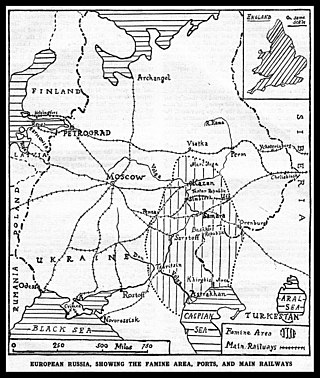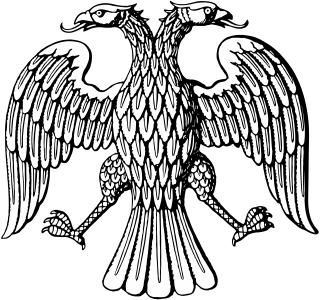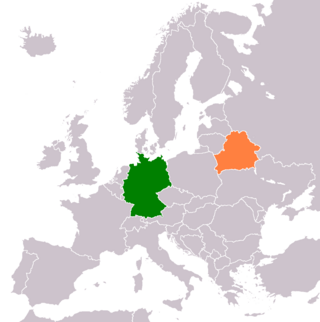Related Research Articles

Fridtjof Wedel-Jarlsberg Nansen was a Norwegian polymath and Nobel Peace Prize laureate. He gained prominence at various points in his life as an explorer, scientist, diplomat, humanitarian and co-founded the Fatherland League.
The German minority population in Russia, Ukraine, and the Soviet Union stemmed from several sources and arrived in several waves. Since the second half of the 19th century, as a consequence of the Russification policies and compulsory military service in the Russian Empire, large groups of Germans from Russia emigrated to the Americas, where they founded many towns. In 1914, an estimate put the remaining number of ethnic Germans living in the Russian Empire at 2,416,290. During World War II, ethnic Germans in the Soviet Union were persecuted and many were forcibly resettled to other regions such as Central Asia. In 1989, the Soviet Union declared to have an ethnic German population of roughly 2 million. By 2002, following the collapse of the Soviet Union in 1991, many ethnic Germans had emigrated and the population fell by half to roughly 1 million. 597,212 Germans self-identified as such in the 2002 Russian census, making Germans the fifth-largest ethnic group in the Russian Federation. There were 353,441 Germans in Kazakhstan and 21,472 in Kyrgyzstan (1999); while 33,300 Germans lived in Ukraine.
The right of return is a principle in international law which guarantees everyone's right of voluntary return to, or re-entry to, their country of origin or of citizenship. The right of return is part of the broader human rights concept freedom of movement and is also related to the legal concept of nationality. While many states afford their citizens the right of abode, the right of return is not restricted to citizenship or nationality in the formal sense. It allows stateless persons and for those born outside their country to return for the first time, so long as they have maintained a "genuine and effective link".

The Byelorussian Soviet Socialist Republic, also known as Byelorussia, Belarusian SSR, Soviet Belarus, or simply Belarus, was a republic of the Soviet Union (USSR). It existed between 1920 and 1991 as one of fifteen constituent republics of the USSR, with its own legislation from 1990 to 1991. The republic was ruled by the Communist Party of Byelorussia and was also referred to as Soviet Byelorussia or Soviet Belarus by a number of historians. Other names for Byelorussia included White Russia or White Russian Soviet Socialist Republic and Belorussian Soviet Socialist Republic.

The First Main Directorateof the Committee for State Security under the USSR council of ministers was the organization responsible for foreign operations and intelligence activities by providing for the training and management of covert agents, intelligence collection administration, and the acquisition of foreign and domestic political, scientific and technical intelligence for the Soviet Union.

Pyotr Nikolayevich Krasnov, also known as Peter Krasnov, was a Russian military leader, writer and later Nazi collaborator.
Operation Trust was a counterintelligence operation of the State Political Directorate (GPU) of the Soviet Union. The operation, which was set up by GPU's predecessor Cheka, ran from 1921 to 1926, set up a fake anti-Bolshevik resistance organization, "Monarchist Union of Central Russia", MUCR, in order to help the OGPU identify real monarchists and anti-Bolsheviks. The created front company was called the Moscow Municipal Credit Association.

The Russian famine of 1921–1922, also known as the Povolzhye famine, was a severe famine in the Russian Soviet Federative Socialist Republic that began early in the spring of 1921 and lasted until 1922. The famine resulted from the combined effects of economic disturbance from the Russian Revolution, the Russian Civil War, and the government policy of war communism. It was exacerbated by rail systems that could not distribute food efficiently.
The repatriation of the Cossacks or betrayal of the Cossacks occurred when Cossacks, ethnic Russians and Ukrainians who were opposed to the Soviet Union and fought for Nazi Germany, were handed over by British and American forces to the Soviet Union after the conclusion of World War II. Towards the end of the European theatre of World War II, many Cossacks forces with civilians in tow retreated to Western Europe. Their goal was to avoid capture and imprisonment by the Red Army for treason, and hoped for a better outcome by surrendering to the Western Allies, such as to the British and Americans. However, after being taken prisoner by the Allies, they were packed into small trains. Unbeknownst to them, they were sent east to Soviet territories. Many men, women and children were subsequently sent to the Gulag prison camps, where some were brutally worked to death. The repatriations were agreed upon at the Yalta Conference; Soviet leader Joseph Stalin claimed that the prisoners were Soviet citizens as of 1939, although there were many of them that had left the country before or soon after the end of the Russian Civil War or had been born abroad, hence never holding Soviet citizenship.
Russian Australians comprise Australian citizens who have full or partial Russian heritage or people who emigrated from Russia and reside in Australia.

Throughout the history of the Soviet Union (1917–1991), there were periods when Soviet authorities suppressed and persecuted various forms of Christianity to different extents depending on state interests. Soviet Marxist-Leninist policy consistently advocated the control, suppression, and ultimately, the elimination of religious beliefs, and it actively encouraged the propagation of Marxist-Leninist atheism in the Soviet Union. However, most religions were never officially outlawed.

After World War II there were from 560,000 to 760,000 Japanese personnel in the Soviet Union and Mongolia interned to work in labor camps as POWs. Of them, it is estimated that between 60,000 and 347,000 died in captivity.

Ukrainian nationality law details the conditions by which a person holds nationality of Ukraine. The primary law governing these requirements is the law "On Citizenship of Ukraine", which came into force on 1 March 2001.

There is a significant Russian population in Germany. The collapse of the Soviet Union in 1991 triggered mass immigration to the West, with Germany being the top destination, mostly for economic and ethnic reasons. Russians are the 3rd largest migrant group in Germany.
Oralman is a term used by Kazakh authorities to describe ethnic Kazakhs who have re-immigrated to Kazakhstan since the country gained independence from the Soviet Union in 1991.

The All Russian Constituent Assembly was a constituent assembly convened in Russia after the February Revolution of 1917. It met for 13 hours, from 4 p.m. to 5 a.m., 18–19 January [O.S. 5–6 January] 1918, whereupon it was illegally dissolved by the Bolshevik-led All-Russian Central Executive Committee, proclaiming the Third All-Russian Congress of Soviets the new governing body of Russia.
From the beginning of the Second World War, the Soviet policy—intended to discourage defection—advertised that any soldier who had fallen into enemy hands, or simply encircled without capture, was guilty of high treason and subject to execution, confiscation of property, and reprisal against their families. Issued in August 1941, Order No. 270 classified all commanders and political officers who surrendered as culpable deserters to be summarily executed and their families arrested. Sometimes Red Army soldiers were told that the families of defectors would be shot; although thousands were arrested, it is unknown if any such executions were carried out. As the war continued, Soviet leaders realized that most Soviet citizens had not voluntarily collaborated. In November 1944, the State Defense Committee decided that freed prisoners of war would be returned to the army while those who served in German military units or police would be handed over to the NKVD. At the Yalta Conference, the Western Allies agreed to repatriate Soviet citizens regardless of their wishes. The Soviet regime set up many NKVD filtration camps, hospitals, and recuperation centers for freed prisoners of war, where most stayed for an average of one or two months. These filtration camps were intended to separate out the minority of voluntary collaborators, but were not very effective.
The main wave of Crimean Tatar repatriation occurred in the late 1980s and early 1990s when over 200,000 Crimean Tatars left Central Asia to return to Crimea whence they had been deported in 1944. While the Soviet government attempted to stifle mass return efforts for decades by denying them residence permits in Crimea or even recognition as a distinct ethnic group, activists continued to petition for the right of return. Eventually a series of commissions were created to publicly evaluate the prospects of allowing return, the first being the notorious Gromyko commission that lasted from 1987 to 1988 that issued declaring that "there was no basis" to allow exiled Crimean Tatars to return en masse to Crimea or restore the Crimean ASSR.
Deportation of Soviet citizens for forced labour to Germany was the forcible export of citizens of the USSR to forced labor in Germany, as well as to Austria, France (Alsace-Lorraine) and the Czech Republic. It was carried out by the German occupation authorities in the period from 1942 to 1944. In November 1941, after the German top leadership realized the failure of the blitzkrieg, they were instructed to use "Russian labor force" in Germany. In January 1942, the German leaders gave orders to take 15 million workers from occupied areas in the USSR to Germany for forced labor.

Germany has an embassy in Minsk. Belarus has an embassy in Berlin, a consulate general in Munich, and two honorary consulates in Cottbus and Hamburg.
References
- 1 2 Stephen Schwartz (January 24, 1988). "Intellectuals and Assassins - Annals of Stalin's Killerati". The New York Times . Retrieved August 6, 2012.
- 1 2 3 N.L Pushkareva Formation of Russian diaspora abroad, pages 53-65, journal «History of Russia» by Institute of Russian history, Moscow: Science (Наука), 1996. — N 1. — 224 p.